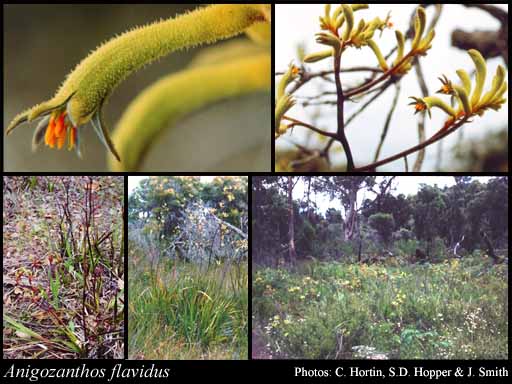- Reference
- Liliac. [Redouté] 3(30): Pl. 176 (1807)
- Conservation Code
- Not threatened
- Naturalised Status
- Native to Western Australia
- Name Status
- Current
Rhizomatous, perennial, herb, 0.5-3 m high. Fl. yellow-green/brown-red, Nov to Dec or Jan. Grey or yellow sand, clay, gravel. Drainage lines, fringing wetlands, roadside gutters.

Scientific Description
Leaves flat, 390-520 mm long, 3-10 mm wide; bristles or hairs on the leaf margin absent; hairs on the surface of the leaf absent (leaf surfaces glabrous). Scape present, hairy, 590-700 mm long. Inflorescence subtended by a bract 8-20 mm long, with several flowers; floral bracts 5-7 mm long; pedicels present, 3-6 mm long; flowers 35-40 mm long. Perianth hairy, bilaterally symmetric, uniformly coloured or suffused with a darker colour over the base colour, yellow, green or red or reddish-brown to purple, with six more or less equal tepals, the inner segments 8-11 mm long. Stamens six, in one level; filaments 3.2-4.2 mm long; anther 2.5-3 mm long, with an appendage. Style 31-38 mm long. Flowers in January, November or December. Occurs in the Swan Coastal Plain, Jarrah Forest, Warren and Esperance IBRA bioregion(s), of the South-west Botanical Province.
Distribution
- IBRA Regions
- Esperance Plains, Jarrah Forest, Swan Coastal Plain, Warren.
- IBRA Subregions
- Fitzgerald, Perth, Southern Jarrah Forest, Warren.
- IMCRA Regions
- WA South Coast.
- Local Government Areas (LGAs)
- Albany, Augusta Margaret River, Bayswater, Bridgetown-Greenbushes, Busselton, Capel, Collie, Cranbrook, Denmark, Donnybrook-Balingup, Harvey, Manjimup, Nannup, Plantagenet.